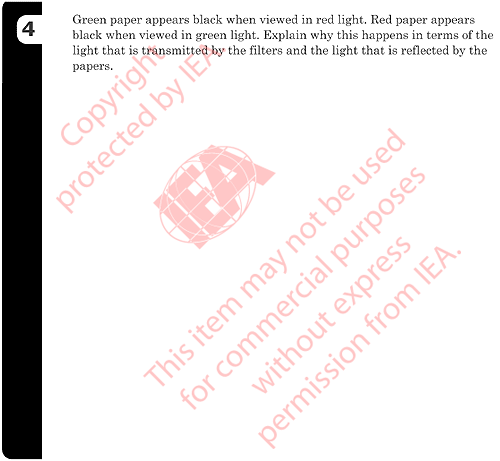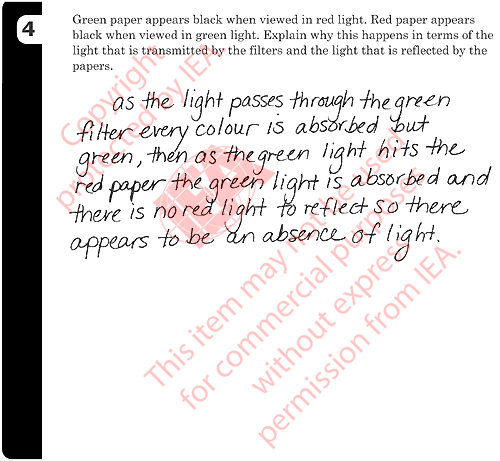Grade 8 Science: Light Filters
Grade 8 Science: Light Filters
1A: Color of Light Reflected by Papers
Correct Responses
-
Identifies the correct color(s) reflected by each piece of paper:
- Paper 1: White
- Paper 2: Red
- Paper 3: Green
- Paper 4: No colors
-
As above but identifies that Paper 1 (white) reflects ‘all’ colors
(may indicate this with just a list of colors from the table or the
additive primaries – red, green, and blue).
Partial Responses
-
Correctly identifies Papers 1, 2 and 3 only; Paper 4 is identified
as reflecting ‘black’ light.
-
Other partially correct (that identifies 2 or 3 papers correctly)
Incorrect Responses
-
Identifies only one paper correctly.
- Other incorrect
1B: Demonstration of Sunlight Separated Into Colors
Correct Responses
-
Mentions the use of a prism or equivalent.
-
Mentions a rainbow.
-
Mentions sunrise and/or sunset.
-
Mentions a way to demonstrate combining light colors (red, green, blue)
to produce white light.
- Other correct
- Examples:
- Soap bubbles.
- Oil slicks.
Incorrect Response
Grade 8 Science: Light Filters
Grade 8 Science: Light Filters
2: Comparing Color of Light from Flashlight and Sunlight
Correct Response
- Explains that the color (spectra) of the two light sources must be the same/similar (white light) based on the results of the experiment.
- Examples:
- Since the papers looked the same color, the light from the flashlight must be pretty much the same as sunlight.
- They both are white light.
- The colors reflected by the papers are the same, so the light must be the same.
- Note: For full credit, a response must refer to the color (spectrum) of the light sources explicitly or implicitly by referring to the experimental results (similarity in the appearance of the different colored papers).
Partial Response
- Mentions only that sunlight and the flashlight are the ‘same’ with no further justification.
Incorrect Responses
- Mentions only that sunlight and flashlight are different.
- Examples:
- They both have different types of rays coming from them.
- Other incorrect
Grade 8 Science: Light Filters
Grade 8 Science: Light Filters


4: Explaining Why Green/Red Paper Appear Black Under Red/Green Light
Correct Response
-
Explanation refers to the color(s) of light absorbed, reflected or
transmitted by the paper(s) AND the filter(s).
- Examples:
- Only green light passes through the green filter. When it
hits the red paper it is not reflected because the red
paper reflects mostly red light. So it looks black.
Partial Responses
-
Explanation refers ONLY to the color(s) of light absorbed/reflected
by the papers(s).
- Examples:
- When red light shines on green paper, the red light will
all be absorbed.
-
Explanation refers ONLY to the color(s) of light absorbed/transmitted
by the filters(s).
- Examples:
- There is no green light coming through the red filter, so
you can ’t see the green color of the paper.
Incorrect Responses
-
Mentions only color mixing.
- Examples:
- Because red and green mixed together makes black.
-
Mentions reflection, transmission or absorption of light, but with
no or incorrect identification of the specific colors involved.
- Examples:
- The other colors get reflected.
- When the filter absorbs a color it appears black.
- Other incorrect
Grade 8 Science: Light Filters
5: Effect of Filters on Dye Fading
Correct Responses
-
States that filters absorb (certain colors) of light. [Uses correct
scientific terms.]
- Examples:
- Filters are used to absorb the color of sunlight that is
causing the fading.
- Because of the light absorption by the filters.
-
Refers to filters ‘blocking’ light or similar. [Uses
non-scientific terms.]
- Examples:
- When filters are placed over the photograph, they only
let some of the light through.
- Less sunlight reaches the photograph when there is a filter.
- The filters block out the light.
Incorrect Responses
-
Refers only to an effect or property of sunlight; no explicit mention
of the function of filters.
- Examples:
- The sunlight is very strong.
- Sunlight contains a mixture of colors.
- Other incorrect
|
|
© 2008 International Association for the Evaluation of Educational Achievement (IEA)










